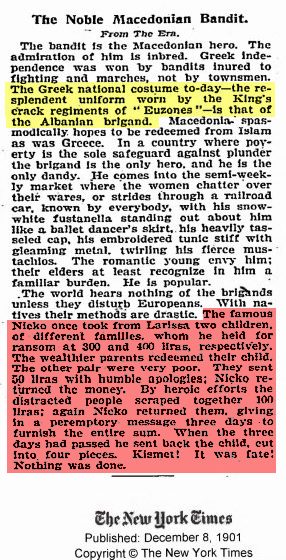Уште една своевремена новинарска потврда дека познатата грчка фустанела била преземена од албанската традиција.
Иако во насловот се нарекува благороден и македонски бандит мисли на грчки андарт и сѐ само не благороден. Така при дното на статијата опишува за драстичните методи кои биле употребувани од страна на грчките “борци за ослободување на Македонија”. Така некој си Нико киднапирал две деца од две семејства. Побарал по 300 и 400 лири. Побогатото семејство на едното дете го платило откупот и детето им било вратено. Другото дете било од сиромашно семејство некако едвај собрале прво 50 потоа и 100 лири. Бандитот им ги вратил парите и детето исечено на 4 дела.
„…
The Noble Macedonian Bandit.
From The Ern.
The bandit Is the Macedonian hero. The
admiration of him ɪs inbred. Greek inde-
pendence was won by bandits inured to
fighting and marches, not by townsmen.
The Greek national costume to-day—the re-
splendent uniform worn by the King’s
crack regiments of “ Euzones ”—Is that of
the Albanian brigand. Macedonia-* spas-
modically hopes to be redeemed from Islam
as was Greece, ɪn a country where pov-
erty is the sole safeguard against plunder
the brigand Is the only hero, and he is the
only dandy. He comes Into the semi-week-
ly market where the women chatter over
their -wares, or strides through a railroad
car, known by everybody, with his snow-
white fustanella standing out about him
like a ballet dancer’s skirt, his heavily tas-
seled cap, his embroidered tunic stiff with
gleaming metal, twirling his fierce mus- •
tachios. The romantic young envy him;
their elders at least recognize in him a
familiar burden. He is popular.
.The world hears nothing of the brighnðs
unless they disturb Europeans. With na-
tives their methods are drastic. The famous
Mieko once took from Larissa tvro children,
of different families, whom he held for
ransom at 300 and 400 liras, respectively.
The wealthier parents redeemed their child.
The other pair were very poor. They sent
50 liras with humble apologies; Nlcko re-
turned the money. By heroic efforts the
distracted people scraped together 100
liras; again Nicko returned them, giving
in a peremptory- message three days to
furnish the entire sum. When the three
days had passed he sent back the child, cut
into, four pieces. Kismet! It was fate!
Nothing was done.
Eljc iXcUr l]ork Simes
Published: Decembers, 1901
Copyright © The New York Times …“
Посочил: Ѕале











